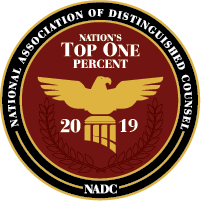
Future Lost Income And Work-Life Expectancy
by Richard M. Martin, Jr.
Lamothe Law Firm, LLC
If you represent maritime injury victims in federal court, one of your routine tasks is exchanging economic reports. Your client’s report typically projects future lost income based on a work-life expectancy ranging between mid-50s to Social Security retirement age. Why? Because maritime employment provides career paths from roustabout to OIM, or from deck hand to vessel master. Many offshore workers enjoy multi-decade work-lives, and that fact is demonstrated by the “company man” who often appears as a Fed. R. Civ. P. 30(b)(6) witness.
Despite the reality of long careers, the defense economic report will always say that your client has no meaningful offshore work-life expectancy. If you practice before the U.S. District Court for the Eastern District of Louisiana, you’ve probably seen a dozen reports by a favorite defense economist which all state:
“The potential loss period is the worklife expectancy of Mr. Smith. For the purposes of estimating worklife I have used the most recent figures released by the U.S. Department of Labor’s Bureau of Labor Statistics (Bulletin 2254, February 1986), as updated in Checka, Donley and Goldman, Journal of Labor Economics, Vols. 9, No. 3 (Winter 1999-2000) and 10, No. 3 (Winter 2000-01).”
(Bold emphasis added.)
Are you disturbed by defendants presently relying on work life figures from 1986, which were “updated” sixteen years ago. You should be. President Reagan was halfway through his second term in 1986, and pay phones were everywhere.1 In 2001, the time of the last updates, President Clinton was finishing his second term. Prepare to be further disturbed.
In Barto v. Shore Constr., L.L.C.,2, the Fifth Circuit considered the issue of work-life expectancy. Mr. Barto, a Jones Act seaman, was injured when he fell while working on a derrick barge operated by McDermott, Inc. At bench trial, the Eastern District noted that plaintiff’s expert economist provided wage loss estimates for work-life expectancies of age 55 to “age 67, which is the Social Security requirement age for Mr. Barto.” Then it found a middle ground it considered a reasonable estimation of Barto’s loss of future earning capacity.3 McDermott’s expert economist provided a different range of estimates based on a retirement age of 58.2, which its expert selected based on a work-life expectancy table from the U.S. Department of Labor’s Bureau of Labor Statistics.
On appeal, McDermott argued that an award for future lost wages should generally be based upon a seaman’s work-life expectancy, meaning “the average number of years that a person of a certain age will both live and work.” Madore v. Ingram Tank Ships, Inc.4 “Such an average is not conclusive. It may be shown by evidence that a particular person, by virtue of his health or occupation or other factors, is likely to live and work a longer, or shorter, period than the average.”5 “Absent such evidence, however, computations should be based on the statistical average.”6 Can you see how this is a problem when the Fifth Circuit approves using a “statistical average” work-life expectancy, and then the defendant uses one last “updated” when Bill and Hillary lived in the White House?
The Fifth Circuit held that Barto’s economist did not provide any reason to believe that Barto would continue to work past his statistical work-life expectancy. The only evidence Barto presented at trial was his testimony that he planned to work “[a]s long as I can retire. Whatever the retirement age is.” This was not enough to show that Barto “by virtue of his health or occupation or other factors, is likely to live and work a longer, or shorter, period than the average.” Madore.7
The Fifth Circuit noted, critically, that Barto did not specifically testify that he planned to work until age 67, and nothing indicated that he knew that this was the Social Security retirement age. Then it focused on the critical issue which will affect both plaintiff’s trial and deposition testimony and expert economic reports: wanting to work until age 67 is not the only or even the most significant factor in determining whether someone actually will work until age 67.8 Because Barto presented no evidence that such events were particularly unlikely given his health or other factors, he did not successfully rebut the presumption that the average work-life expectancy should apply.9 So, what to do about this problem?
The starting point is plaintiff’s economic expert. He or she should present work-life expectancy opinions based upon up-to-date studies. The economist can also be provided with “careerist” information from the client’s personnel file, as well as directly from the client, which relate to, e.g., his plans to make a career, and things that evidence his progress on that career path (i.e., obtaining more significant licenses, special certifications, promotions, supervisory duties, positive performance evaluations, participation in long-term company fringe benefit programs, etc.).
The “company man” 30(b)(6) witness can be an effective witness for your client’s work-life expectancy. So, in your notice of the defendant’s 30(b)(6) deposition, consider listing the following as topics of examination:
(1) The experience and qualifications of the designated witness over his decades offshore. He becomes the “long term template” for your younger injured client.
(2) Defendant employer’s own offshore career promotion path from roustabout to OIM as described in its own HR materials or employee handbook.
(3) Plaintiff’s job annual performance reviews, pay raises, and promotions which are recorded in his personnel file. These show a career path.
(4) Eligibility for and vesting of plaintiff’s financial fringe benefits based on his tenure offshore. These show a career path.
(5) Plaintiff’s annual “safe work” anniversaries and awards in his personnel file. These show a career path.
(6) Plaintiff’s initial employment “unrestricted duty” physical examination medical report in his personnel file. This clearance, plus your client’s pre-accident history of no other injuries, shows he was physically qualified to advance in his career.
Plaintiff’s treating physician and your vocational rehabilitation expert can also help. The doctor can testify that plaintiff’s uninjured pre-accident physical status would have permitted him to continue working his way to more senior positions. Your voc-rehab expert can offer testimony that the more senior positions become less physically demanding, and that based on testing your client possesses the skills required for promotions.
Then, there is your client. His testimony should include why he chose an offshore career with “company x”, his plans to make a career, and things in his personnel file that evidence his progress on that career path (i.e., obtaining more significant licenses, special certifications, promotions, supervisory duties, positive performance evaluations, participation in long-term company fringe benefit programs, etc.). The objective, here, is to provide the district court with enough evidence to decide that your client (but for his injury by the defendant) would have been a “lifer” offshore, and to prevent a reversal upon appeal.
Presenting sufficient evidence of your client’s intention, his success on the pathway to seniority, and his pre-accident physical ability to perform the jobs in his prospective career path is necessary to beat the statistical work life expectancy trap at trial or the standard of review on appeal. “The standard of review for a bench trial is well established: findings of fact are reviewed for clear error and legal issues are reviewed de novo.” Becker v. Tidewater, Inc.10 Reversal is warranted under clear error review only if the court is “left with the definite and firm conviction that a mistake has been committed.” Jauch v. Nautical Servs., Inc.11
With respect to jury trials, the jury “may draw reasonable inferences from the evidence,” and appellate courts may not substitute other inferences for the “jury’s reasonable factual inferences.” Brown v. Parker Drilling Offshore Corp.12 “Very little evidence is sufficient to make an issue one for the jury.”13 Evidence is reviewed in the light most favorable to the verdict. Rivera v. Union Pac. R.R. Co.14 “Only when there is a complete absence of probative facts to support the conclusion reached does a reversible error appear.” Lavender v. Kurn.15
1 For my younger readers, a “pay phone” was a primitive land line device which sold telephone calls. In vending machine fashion, they required the user to deposit coins. Many of them featured something called a “rotary dial.”
2 801 F.3d 465 (5th. Cir., 2015).
3 Barto’s economist provided an age range for future lost wages: 55.8 and 67 years. 55.8 was selected based on a table of statistical work-life expectancies prepared by other economists. 67 was selected because it was the “full retirement age” determined by the Social Security Administration.
4 732 F.2d 475, 478 (5th Cir.1984).
5 Id.
6 Id.
7 732 F.2d at 478.
8 An employee “might have become disabled before [the Social Security retirement age] as a result of illness or some other misadventure.” Or the employee “might have died before then.” Id.
9 “It is a basic concept of damages that they must be proved by the party seeking them.” Servicios–Expoarma, C.A. v. Indus. Mar. Carriers, Inc., 135 F.3d 984, 995 (5th Cir.1998).
10 586 F.3d 358, 365 (5th Cir.2009), quoting In re Mid–South Towing Co., 418 F.3d 526, 531 (5th Cir.2005).
11 470 F.3d 207, 213 (5th Cir.2006) (per curiam), quoting Anderson v. City of Bessemer, 470 U.S. 564, 573, 105 S.Ct. 1504, 84 L.Ed.2d 518 (1985).
12 410 F.3d 166, 182-83 (5th Cir. 2005).
13 9B Charles Alan Wright & Arthur R. Miller, Federal Practice and Procedure § 2526 (3d ed. 2008).
14 378 F.3d 502, 508-09 (5th Cir. 2004).
15 327 U.S. 645, 653 (1946).








